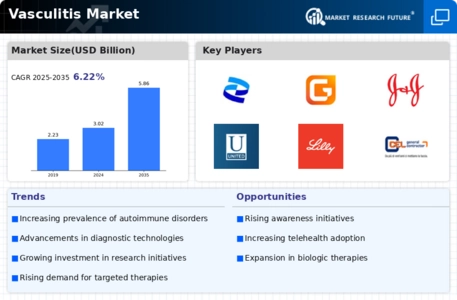Emergence of Biologic Therapies
The emergence of biologic therapies represents a transformative shift within the Vasculitis Market. These therapies, which target specific components of the immune system, have shown promise in treating various forms of vasculitis. The market for biologics is expected to witness substantial growth, with projections indicating a potential increase in market size by over 15% in the coming years. This growth is driven by the increasing number of clinical trials and the approval of new biologic agents, which offer more effective treatment options for patients. As healthcare providers increasingly adopt these therapies, the Vasculitis Market is likely to expand, reflecting a broader trend towards precision medicine and tailored treatment approaches.
Increasing Incidence of Vasculitis
The rising incidence of vasculitis is a notable driver in the Vasculitis Market. Recent studies indicate that the prevalence of vasculitis has been increasing, with estimates suggesting that approximately 20 to 30 cases per 100,000 individuals are diagnosed annually. This uptick in cases necessitates enhanced healthcare services and treatment options, thereby propelling market growth. As healthcare providers become more adept at diagnosing and managing these conditions, the demand for specialized therapies and interventions is likely to rise. Furthermore, the increasing recognition of vasculitis as a significant health concern among healthcare professionals and patients alike contributes to the expansion of the Vasculitis Market, as it fosters a more proactive approach to treatment and management.
Innovations in Diagnostic Techniques
Innovations in diagnostic techniques are transforming the landscape of the Vasculitis Market. Advanced imaging technologies, such as MRI and PET scans, alongside improved laboratory tests, facilitate earlier and more accurate diagnosis of vasculitis. This is crucial, as timely diagnosis can significantly impact treatment outcomes. The market for diagnostic tools is projected to grow, with estimates indicating a compound annual growth rate of around 7% over the next few years. Enhanced diagnostic capabilities not only improve patient management but also stimulate the demand for targeted therapies, thereby driving the overall growth of the Vasculitis Market. As healthcare systems adopt these innovations, the potential for better patient outcomes becomes increasingly apparent.
Rising Patient Advocacy and Support Groups
Rising patient advocacy and support groups play a pivotal role in shaping the Vasculitis Market. These organizations are instrumental in raising awareness about vasculitis, providing education, and advocating for better treatment options. Their efforts contribute to increased visibility of the disease, which in turn drives demand for healthcare services and innovative therapies. The presence of active advocacy groups has been linked to improved patient outcomes, as they facilitate access to information and resources. Furthermore, as these groups continue to grow in number and influence, they are likely to impact funding for research and development in the Vasculitis Market, fostering an environment conducive to advancements in treatment and care.
Growing Investment in Research and Development
Growing investment in research and development (R&D) is a critical driver of the Vasculitis Market. Pharmaceutical companies and research institutions are increasingly allocating resources to explore new treatment modalities and understand the underlying mechanisms of vasculitis. This trend is evidenced by a rise in funding for clinical trials and innovative research projects, which aim to develop novel therapies and improve existing treatment protocols. The R&D expenditure in the field of autoimmune diseases, including vasculitis, is projected to increase significantly, potentially exceeding $10 billion in the next few years. Such investments not only enhance the understanding of vasculitis but also pave the way for breakthroughs that could reshape the treatment landscape, thereby propelling the Vasculitis Market forward.


















Leave a Comment